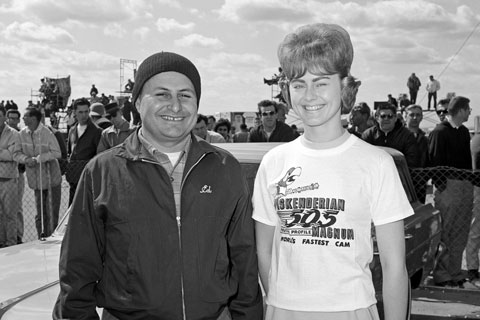SEMA News—March 2014
HERITAGE
By Drew Hardin
Photo Courtesy Petersen Archives
Dawn of an Era
 Actually, the photo you see here represents the dawn of several eras. The picture was taken at the very first SEMA Show, which was known in 1967 as the High Performance & Custom Trade Show and was held in January of that year at Dodger Stadium in Los Angeles. The car in the booth is a Camaro, Chevrolet’s answer to Ford’s wildly popular Mustang.
Actually, the photo you see here represents the dawn of several eras. The picture was taken at the very first SEMA Show, which was known in 1967 as the High Performance & Custom Trade Show and was held in January of that year at Dodger Stadium in Los Angeles. The car in the booth is a Camaro, Chevrolet’s answer to Ford’s wildly popular Mustang.
After letting Ford own the personal sporty-car market for more than two years, Chevrolet finally introduced its entry into the pony-car segment just a few months prior to the trade show. For musclecar enthusiasts, the booth represents a watershed moment—the very first Chevrolet dealer, Nickey Chicago, to offer a big-block conversion for the Camaro, developed by Nickey and race car builder Bill Thomas.
Not only did the Mustang have a two-year-plus head start on the Camaro by the ’67 model year, but it was also available with engine choices that could be tailored to just about any buyer, from frugal six-cylinders to a torquey 390-in. big-block V8. Step up to one of Carroll Shelby’s Mustangs, the GT 500, and you could have a 428-in. V8 with an eye-popping 355 hp and 420 lb.-ft. of torque. Camaro, too, had an assortment of choices, but the most powerful engine available was a 396-in. V8 that made fewer ponies than Ford’s top motor—and it wasn’t available until several months after the Camaro’s introduction.
Those dealers who specialized in high-performance Chevrolet models knew as soon as the first Camaros rolled into their showrooms that the car would suffer horsepower-wise in comparison to the Mustang. But only a handful had the imagination and resources to do anything about it. One of those was Nickey, which had been involved with road and drag racing since the late ’50s.
When the first shipment of Camaros arrived at Nickey, the service techs began measuring the engine bay, wondering if the Corvette’s 425hp 427 V8 would fit. With technical help from Bill Thomas and drag racer Dick Harrell, Nickey performed its first 427 conversion in late 1966, providing its performance-oriented clientele with a real rival to the most powerful Mustangs. Midwest and Eastern customers could order their 427 Camaros from Nickey, while Thomas—headquartered in Anaheim—would convert cars and handle sales for the Western states.
Other dealers would soon follow suit: Dana Chevrolet in South Gate, California, was an early big-block converter; and probably the most famous of the Camaro conversions came from Don Yenko’s dealership in Canonsburg, Pennsylvania. The earliest of the supercar Camaros, like the car in this booth, are now highly sought by collectors. Few were made in that first Camaro model year, and even fewer survived the stress and repeated upgrades that came with life lived on the dragstrip.






